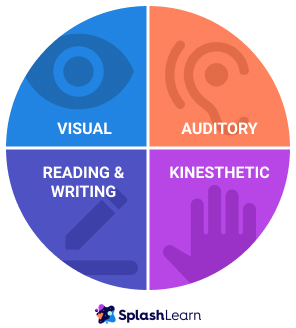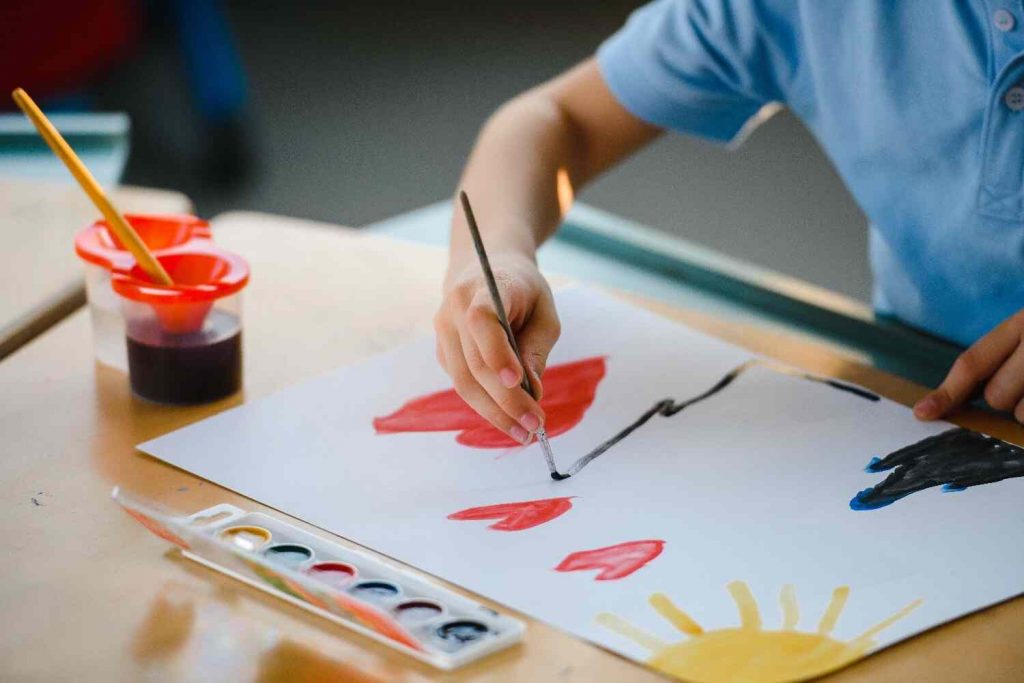Children see the world in their own ways; therefore, their learning styles also vary. Because of this, parents and teachers often face challenges in making them learn. They also use differentiated instruction to help kids learn & retain concepts better.
Math & ELA | PreK To Grade 5
Kids see fun.
You see real learning outcomes.
Watch your kids fall in love with math & reading through our scientifically designed curriculum.
Parents, try for free Teachers, use for free
So, first, we have to understand and acknowledge the children’s individual needs to make them learn.
How do Kids Learn?
Every kid has a strategy that they use to remember information more efficiently. While studying, some students take notes, some make diagrams, and some prefer to listen to lectures. Since no learning style fits all students, scientists have researched to understand the way students learn.
Let’s look at the different types of learning that the scientists have distinguished.
Exploring Learning Styles: The VARK Model
One of the popular theories that scientists have developed to make children learn is called the VARK model. The acronym VARK stands for Visual, Aural, Read/Write, and Kinesthetic sensory modalities that are used for learning. This model was suggested by Fleming and Mills to reflect the experiences of the students and teachers in 1992.
The VARK model identifies four types of learners – visual, aural, read/write, and kinesthetic.

Most children are a combination of these four styles, but very often, they have a predominant learning style. Each of these styles has a complementary way of teaching. Now, let’s see the characteristics each of these styles entails and how to use them best to make children learn.
We will also discuss how to identify children based on their learning needs and adopt suitable teaching methods for them.
Visual Learning Style
Visual learners take in information visually through maps, graphs, diagrams, and charts. However, they don’t necessarily respond well to photos or videos. They prefer absorbing information using different visual aids such as patterns and shapes.
The best way to present information to such children is by visually showing them the relationship between different ideas. For instance, when explaining a scientific process, it can be done by using a flow chart.
Related Reading: Best Tips for Creating a Healthy Student-Centered Learning Environment

How do we identify visual learners?
Visual learners enjoy observing and analyzing things like pictures, diagrams, and charts that showcase information in order of importance. You can find visual learners by paying attention to students who are doodling, making lists in class, or diligently taking notes.
How do we teach them?
If you’re using a whiteboard or smartboard or giving a presentation, make sure such a child has enough time to process and absorb visual information. The child should have access to supplementary handouts that detail subject matter through clear visuals whenever possible.
Additionally, allow these learners to draw pictures, diagrams, or doodles of their learning to reinforce retention.
Aural Learning Style
Aural learners learn better through hearing or spoken words. Saying things to them loudly helps them understand and retain concepts. Such children learn through lectures and group discussions. They can benefit from repeating the lessons, having recordings of the lectures, and group activities where the classmates explain ideas.
How do we identify aural learners?
Aural learners prefer learning subject matter that is presented through sound. Such children actively engage with lectures. You may find them nodding along or asking frequent questions rather than taking written notes. Additionally, such children might read slowly and read aloud to themselves. They might also repeat things you tell them to help with retention.
How do we teach them?
When you’re lecturing, make sure you involve such children in the conversation. Have them verbally detail a new concept they just learned, and ask them follow-up questions while giving them the time they need to respond. Group discussions, engaging videos, and audio recordings are other great ways to engage auditory learners in the classroom.
Engross students in learning visually & aurally with engaging and interactive games by SplashLearn. Watch below how kids in Pre-K to Grade 5 can master Math and Reading skills.
Reading/Writing Learning Style
Some children consume information best in words, whether by writing it down or reading it. To them, text is more powerful than any visual or aural representation of an idea.
These children usually perform very well on written assignments. There are different ways to make such learners engage and understand a certain lesson. For instance, it would be best to have them describe charts and diagrams by written statements, take quizzes on the topics, or give them written assignments.
Related Reading: What Is Student Centered Learning? Importance & Benefits
How do we identify reading/writing learners?
Reading/writing learners prefer written words. They are drawn to textbooks, novels, articles, journals, and anything text-heavy. Like visual learners, you can find reading and writing learners by paying attention to students who take elaborate notes, reference the dictionary to learn new words, or use online search engines to answer their questions.
How do we teach them?
Such students prefer more traditional methods of subject matter delivery. So, make them read textbooks, write essays, and perform in-depth research. But, it’s important to ensure that such children have ample time to absorb written course material. They must also be given every opportunity to get their ideas down on paper or a digital device.
Kinesthetic Learning Style
Kinesthetic learners are individuals who prefer to learn by doing. They enjoy hands-on experience. They are usually more in touch with reality and connected to it, which is why they require tactile experience to understand something better.
The best way to present new information to a kinesthetic learner is through personal experience, practice, examples, or simulations. For instance, they can remember an experiment by recreating it themselves.
How do we identify kinesthetic learners?
Such children are “tactile” learners. They prefer to physically act out events or use all of their senses while learning. These types of learners are easy to find, as they likely have difficulty sitting still and might need frequent breaks during heavy studying periods.

Related Reading: How to Make Adding and Subtracting Fractions Easy
How do we teach them?
Ensure active participation for such children. For example, if you’re teaching Shakespeare, have them act out a scene with a few of their kinesthetic-focused peers. You can also teach them through learning games on SplashLearn that encourage these types of learners to use all of their senses at different points in the lesson.
Precisely,
Understanding different learning styles can drastically impact how parents and teachers handle their children or students.
Therefore, pinpoint how a child or student learns best and adjust lessons, keeping in mind the unique needs of the child or student. It can dramatically affect their ability to connect with the subject. And remember, these learning styles don’t end in the house or classroom. So, make sure to connect their learning with real-life situations!
Incorporate all Learning Styles in Your Kids’ Education with SplashLearn
SplashLearn creates appealing resources for kids in Pre-K to Grade 5 to comprise different learning styles.
From engaging and attractive games for visual, aural, and kinesthetic learners to comprehensive courses and worksheets for reading and writing learners, SplashLearn aims to transform learning for kids worldwide.
Frequently Asked Questions (FAQs)
What is meant by learning style?
Learning style can be described as a set of factors, behaviors, and attitudes that facilitate learning for an individual in a given situation. Styles influence how students learn, how teachers teach, and how the two interact.
What is the most common of four learning styles?
Of the four learning styles, that is, visual, aural, read/write, and kinesthetic, visual learners are the most common type of learner, making up 65% of the children. Such children relate best to written information, notes, diagrams, and pictures.
What is a personal learning style?
An individual’s learning style refers to the preferential way in which the student absorbs, processes, comprehends, and retains information. Individual learning styles depend on cognitive, emotional, and environmental factors and prior experience.
What is the difference between VARK questionnaire and Kolb questionnaire?
The VARK questionnaire shows how people use their dominant learning style in an environment, while Kolb’s questionnaire assesses how the students learn.
























